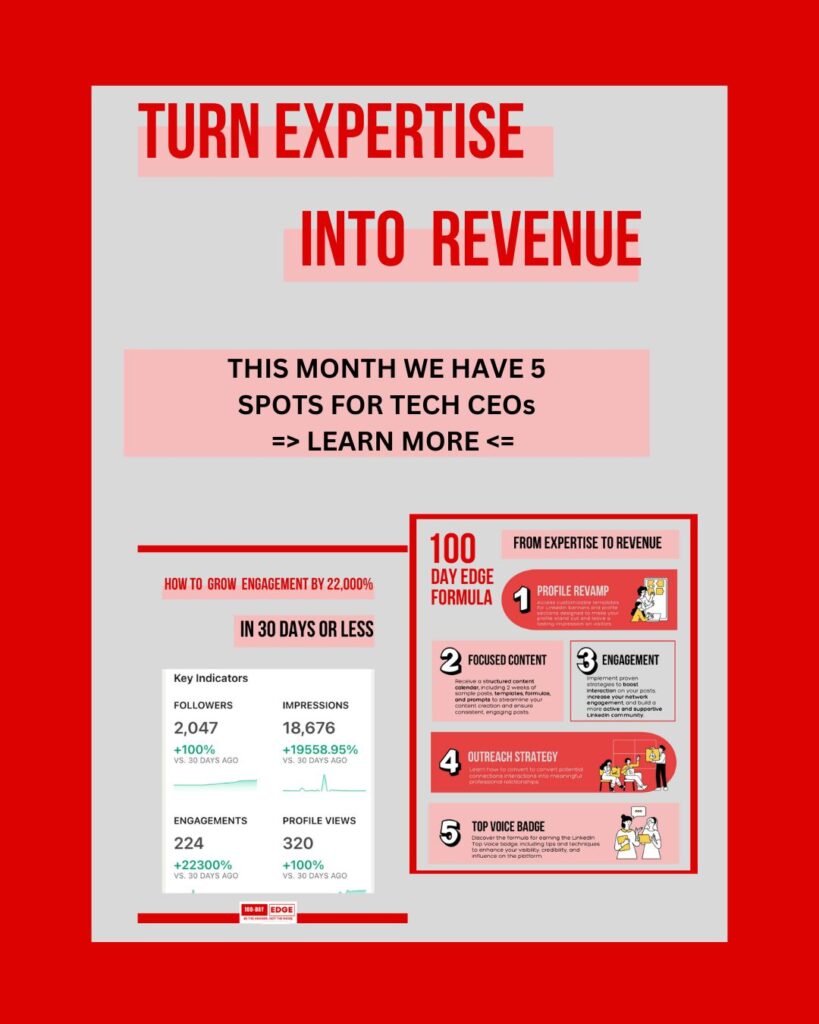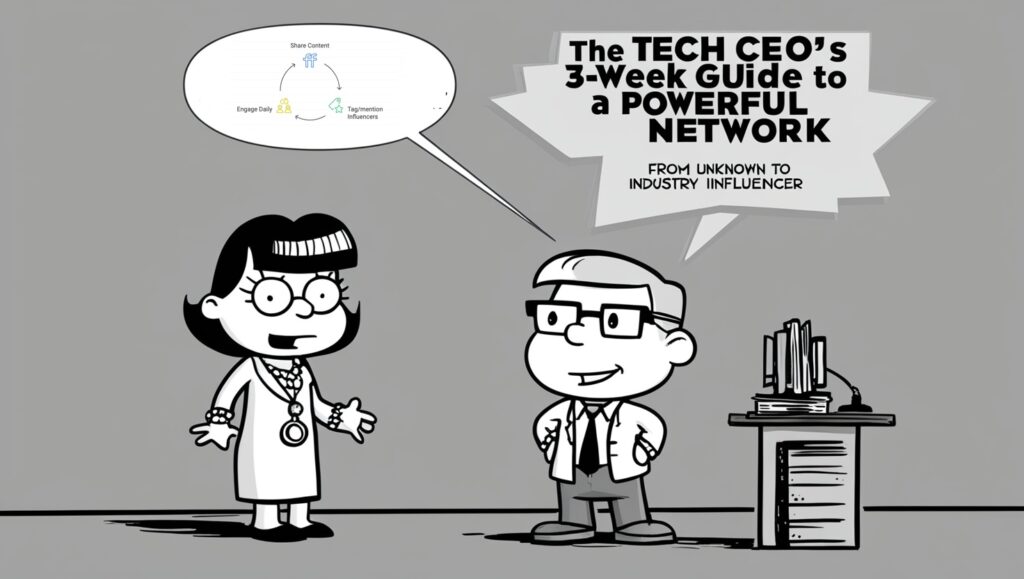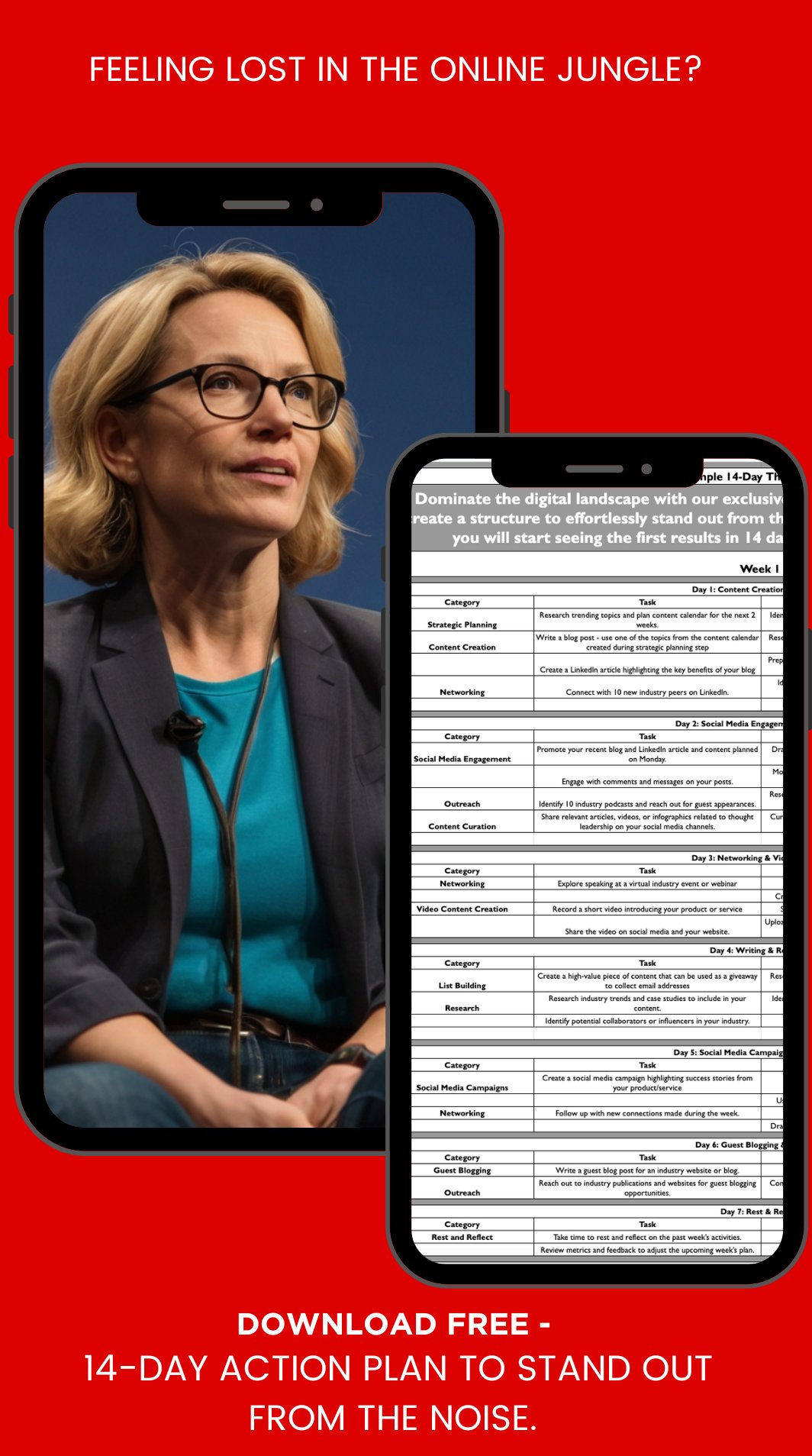“The hardest part? It’s not the 80-hour weeks or the constant firefighting. It’s the silence when you need answers most.”
I heard this from a Series A founder last month, and it hit home harder than any investor pitch deck I’ve seen.
Here’s the reality no one talks about in those glossy “Day in the Life of a CEO” features: Leadership can be surprisingly lonely.
While everyone else in your company has peers to bounce ideas off of, you’re often left playing both chess master and chess piece.
During a recent founder dinner, I asked 12 tech CEOs about their biggest challenge.
Their answers weren’t about funding rounds or product-market fit. Ten out of twelve mentioned the same thing: feeling like they’re building their companies in an echo chamber.
The irony?
In today’s hyper-connected tech ecosystem, most CEOs are just three introductions away from the exact mentor, partner, or advisor they need. But they’re too busy “running the company” to build these life-changing connections.
I know because I’ve been there.
Two years ago, I was that CEO – head down in operations, wondering why other founders seemed to have this mysterious “inner circle” I couldn’t crack.
My network consisted of my team, my board, and a handful of college friends who thought “technical debt” meant unpaid student loans.
Then I discovered something that changed everything: building a powerful network isn’t about attending more events or sending more LinkedIn requests. It’s about mastering a specific sequence of micro-commitments that turn strangers into allies.
Let me show you how to build the kind of network that doesn’t just open doors – it builds entire hallways of opportunity…
Table of Contents
ToggleThe Network You Need vs. The Time You (Don’t) Have
OK – Now we are on the same page:
You know you need a network. A powerful one. One that includes:
- Fellow tech CEOs who can offer battle-tested advice
- Industry leaders who can open doors
- Potential customers who see you as more than just another sales pitch
- Media contacts who turn to you for expert commentary
- Investors who view you as a visionary, not just another pitch deck
But building this network feels like a luxury when your to-do list looks like the unabridged works of Shakespeare.
How do you justify “networking” when you’re knee-deep in product development, team building, and putting out the daily fires that come with running a startup?
The 3-Week Network Building Blueprint
So how do you build this network in a way that doesn’t involve endless coffee meetings or awkward cocktail parties?
You need a method that aligns with your goals, plays to your strengths as a tech leader, and actually drives your business forward.
Welcome to your 3-week plan to go from a lonely CEO to a connected tech leader.
Turn networking from a necessary evil into your secret weapon.
Week 1: Lay the Groundwork
Day 1-2: Define Your Unique Value Proposition (UVP)
Before you can build a network, you need to know what you bring to the table. What makes you, well, you?

Action Item: Spend 30 minutes answering these questions:
What personal experience gives you a unique perspective on your industry?
What unique problem does your company solve?
What unconventional approach or technology are you using?
Remember, your UVP isn’t just about your product.
It’s about you as a leader.
Are you the ex-Google engineer who’s revolutionizing AI ethics? The serial entrepreneur tackling climate change through blockchain? Define it, refine it, own it.
Day 3-4: Audit Your Online Presence
In the digital age, your online presence is often your first impression. Time for a reality check.
Action Item: Google yourself. What shows up? Is it crickets, or is it a cohesive story of a tech visionary?
- To-Do:
- Update your LinkedIn profile with your newly defined UVP
- Ensure your company website has an “About the Founder” section that aligns with your personal brand
- If you don’t have a personal website, set one up (even a simple one-pager will do)

Day 5-7: Identify Your Target Network
Not all networks are created equal. You need to be strategic about who you want in your circle.
Action Item: Create your networking hit list:
- 10 fellow tech CEOs in adjacent (not competing) spaces
- 5 industry thought leaders
- 3 relevant journalists or industry analysts
- 2 potential strategic partners
- 1 “dream mentor” (aim high!)

Pro Tip: Use tools like Crunchbase, LinkedIn, and industry publications to research and compile this list.
Week 2: Create Value and Visibility
Day 8-9: Develop Your Content Strategy
Content is your trojan horse into the circles you want to penetrate. But not just any content—think high-value, industry-specific insights.
Action Item: Brainstorm 10 potential topics you could write about or discuss, based on:
Lessons learned from your funding journey
Unique challenges you’ve faced as a tech CEO
Innovative solutions you’ve implemented
Industry trends you have a strong opinion on

Day 10-12: Create and Publish Your Flagship Content
Time to put pen to paper (or fingers to keyboard).

Action Item: Choose your best topic and create a piece of content:
Option C: Create a detailed Twitter thread (10-15 tweets)
Option A: Write a long-form LinkedIn article (1000-1500 words)
Option B: Record a 10-15 minute video sharing your insights
Whichever format you choose, make sure it showcases your expertise and unique perspective. This is your calling card to the industry.
Day 13-14: Engage and Amplify
Your content is live. Now it’s time to get it in front of the right eyes.

Action Items:
Spend 30 minutes each day engaging with content from your target network (comment, share, add value)
Share your content across all your social platforms
Directly tag or mention 3-5 people from your target network list who might find it valuable
Week 3: Connect and Cultivate
Day 15-16: The Strategic Reach-Out
Cold outreach doesn’t have to feel, well, cold. You’ve laid the groundwork; now it’s time to make those connections.
Action Item: Reach out to 5 people from your target network list:
- Reference a specific piece of their work or a recent achievement
- Share how it resonated with you or impacted your thinking
- Offer a unique insight or perspective on their work
- No ask. Just genuine appreciation and value-add.

Example template:
Hi [Name],
Your recent [article/talk/tweet] on [topic] really resonated with me, especially the point about [specific insight]. It actually made me rethink our approach to [relevant area in your business].
I've been working on a similar challenge in [your specific context] and found that [your unique insight or approach]. Thought you might find it interesting.
Keep up the great work. Your insights are shaping the future of [industry].
Best,
[Your Name]Day 17-18: The Value-First Follow-Up
For those who responded, it’s time to deepen the connection.
Action Item: For each positive response:
- Send a thoughtful follow-up that adds even more value
- Share a resource (could be your flagship content from Week 2, or something else relevant to their interests)
- If appropriate, suggest a brief call to exchange ideas (not to pitch!)

Day 19-20: The Strategic Ask
You’ve built goodwill. Now, it’s time for a strategic, mutually beneficial ask.
- Action Item: Choose 2-3 of your warmest connections and make a specific request:
- Invite them to be a guest on your podcast or video series (if you don’t have one, now’s the time to start!)
- Ask if they’d be open to a 15-minute call to get their perspective on a specific challenge you’re facing
- Propose a joint webinar or content collaboration

The key here is to ensure your ask also provides value to them—exposure to a new audience, insights into a different sector, etc.
Day 21: Reflect and Plan
You’ve come a long way in just three weeks. Time to take stock and plan your next moves.
Action Items:
- Review your networking activities. What worked well? What didn’t?
- Set concrete goals for the next month (e.g., secure 2 podcast guest spots, establish regular communication with 3 fellow CEOs)
- Plan your content calendar for the next month, leveraging the insights and connections you’ve gained

The Road Ahead: From Network to Net Worth
Congratulations! In just three weeks, you’ve laid the foundation for a powerful network that can propel both you and your company to new heights.
But remember, this is just the beginning.
True networking isn’t about collecting connections like Pokémon cards. It’s about building genuine relationships, consistently providing value, and growing together.
As you continue on this journey, keep these principles in mind:
- Consistency is Key: Make networking a part of your daily routine, even if it’s just 15 minutes a day.
- Always Lead with Value: Before you ask for anything, think about what you can give.
- Be Authentically You: In a world of polished PR speak, genuine insights and vulnerability stand out.
- Think Long-Term: The connection you nurture today could be the key to your next big breakthrough tomorrow.
- Leverage Your Network for Growth: As your network grows, look for opportunities to collaborate, cross-promote, and create multiplier effects.
So, here’s to you, tech CEO. To the connections you’ll make, the insights you’ll share, and the incredible journey ahead.
Your network is your net worth—in more ways than one.
Now go out there and change the world, one connection at a time.

This month, my team is helping 5 technology leaders transform their expertise into tangible business results.
In 100 days, you’ll:
- Stage 1: Define your EDGE and optimize your online presence.
- Stage 2: Engage your tribe and land your first high-value client.
- Stage 3: Set your EDGE on fire with strategic content and recurring revenue.
Q1: Why is networking important for CEOs, especially in the tech industry?
Leadership can be a lonely road—while your team members have peers to bounce ideas off of, you’re often facing unique challenges that require a different level of understanding and experience.
A strong network isn’t just about collecting LinkedIn connections; it’s about building a support system that provides:
- Battle-tested advice from CEOs who’ve navigated similar challenges
- Fresh industry insights from thought leaders shaping the future
- Access to game-changing opportunities with potential customers, partners, and investors
Q2: I’m incredibly busy running my company. How can I possibly find time to network effectively?
This is perhaps the most common challenge I hear from fellow CEOs. The key is to approach networking with the same strategic mindset you bring to other aspects of your business. Here’s a practical framework:
- Define your value proposition to focus your efforts
- Audit and optimize your online presence, especially LinkedIn and your website
- Create high-value content that showcases your expertise
- Make strategic connections with key industry players
Pro tip: Block out specific times in your calendar for networking activities, just as you would for other crucial business tasks.
Q3: How can I create a unique value proposition (UVP) that helps me stand out?
Your UVP is your networking superpower. It’s not just another elevator pitch—it’s the authentic combination of your experiences, your company’s solutions, and your distinctive approach to the industry.
Ask yourself:
- What unexpected insights have your past experiences given you?
- How does your company solve problems differently?
- What innovative approaches set you apart?
Remember: Your UVP isn’t just a sales pitch—it’s a genuine reflection of your strengths and contributions to the industry.
Q4: What kind of content should I create to attract the right people to my network?
Content creation is your network magnet. Focus on sharing insights that genuinely help others:
- Document lessons from your funding journey
- Share stories about overcoming specific challenges
- Discuss innovative solutions you’ve implemented
- Offer fresh perspectives on industry trends
Choose a format that plays to your strengths, whether that’s written articles, videos, podcasts, or even detailed Twitter threads.
Q5: How can I reach out to people in my target network without seeming like I’m just trying to sell them something?
The secret lies in focusing on genuine connection and value first:
- Reference specific work they’ve done that resonated with you
- Share how their insights have influenced your thinking
- Offer a unique perspective on their area of expertise
Most importantly: avoid making asks in your initial outreach. Build the relationship first; the opportunities will follow naturally.
Q6: Once I’ve made contact, how do I nurture those relationships and turn them into valuable connections?
Building valuable relationships requires ongoing attention:
- Follow up thoughtfully with relevant resources or insights
- Propose mutually beneficial collaborations, like joint webinars or content creation
- Maintain regular, meaningful communication through sharing articles, commenting on their work, or sending occasional personal messages
Think of it as tending a garden—consistent care yields the best results.
Q7: What are some common networking mistakes CEOs should avoid?
Even experienced CEOs can fall into these networking traps:
- Being too transactional: Focus on relationships, not just what you can get
- Only reaching out when you need something: Engage consistently, not just during crises
- Being inauthentic: People can spot a fake from a mile away—let your genuine personality shine through
Q8: What is the most important thing to remember about building a strong network?
Consistency is key. Make networking a part of your routine, even if it’s just 15 minutes a day. Over time, those small efforts will compound into a powerful network that supports you and your company’s growth.
Remember: Your network is truly your net worth, but more importantly, it’s your support system, your knowledge base, and your community of peers who understand the unique challenges you face as a CEO.
Start small, stay consistent, and watch your network grow into one of your most valuable business assets.
What networking strategies have worked best for you as a CEO? Share your experiences in the comments below.









